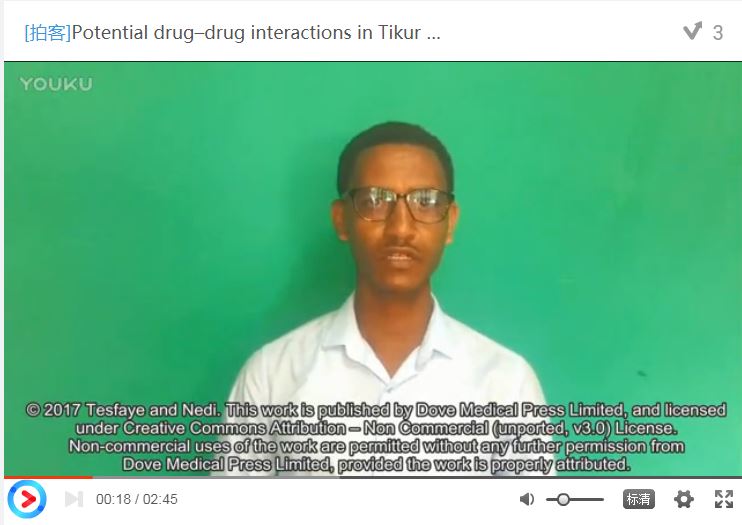9 0 9 6 8
论文已发表
注册即可获取德孚的最新动态
IF 收录期刊
- 2.6 Breast Cancer (Dove Med Press)
- 3.9 Clin Epidemiol
- 3.3 Cancer Manag Res
- 3.9 Infect Drug Resist
- 3.6 Clin Interv Aging
- 4.8 Drug Des Dev Ther
- 2.8 Int J Chronic Obstr
- 8.0 Int J Nanomed
- 2.3 Int J Women's Health
- 3.2 Neuropsych Dis Treat
- 4.0 OncoTargets Ther
- 2.2 Patient Prefer Adher
- 2.8 Ther Clin Risk Manag
- 2.7 J Pain Res
- 3.3 Diabet Metab Synd Ob
- 4.3 Psychol Res Behav Ma
- 3.4 Nat Sci Sleep
- 1.9 Pharmgenomics Pers Med
- 3.5 Risk Manag Healthc Policy
- 4.5 J Inflamm Res
- 2.3 Int J Gen Med
- 4.1 J Hepatocell Carcinoma
- 3.2 J Asthma Allergy
- 2.3 Clin Cosmet Investig Dermatol
- 3.3 J Multidiscip Healthc

Potential drug–drug interactions in inpatients treated at the Internal Medicine ward of Tikur Anbessa Specialized Hospital
Authors Tesfaye ZT, Nedi T
Received 1 November 2016
Accepted for publication 17 June 2017
Published 14 August 2017 Volume 2017:9 Pages 71—76
DOI https://doi.org/10.2147/DHPS.S126336
Checked for plagiarism Yes
Review by Single-blind
Peer reviewers approved by Dr Akshita Wason
Peer reviewer comments 2
Editor who approved publication: Professor Rajender Aparasu
Purpose: Although the concomitant use of multiple drugs often increases
therapeutic effectiveness, certain combinations result in unwanted drug–drug
interactions (DDIs). Most interactions go unnoticed by physicians due to the
absence of new clinical signs and symptoms, and because they often produce a
worsening of already existing symptoms. Quantification of the occurrence of the
potential DDIs is essential to prevent the harmful effects associated with
interactions. This study was launched to assess the prevalence of potential
DDIs in the Internal Medicine ward of Tikur Anbessa Specialized Hospital, Addis
Ababa, Ethiopia.
Patients and methods: Cross-sectional data were gathered from the
medical charts of 252 randomly selected patients who were admitted to the Internal
Medicine ward during August 23 to October 23, 2013, and exposed to at least two
concomitant drugs. Potential DDIs were identified using Medscape Drug
Interaction Checker. The data were analyzed using SPSS software. Logistic
regression analysis was used to determine the presence of association between
variables and p -value <0.05
was considered statistically significant.
Results: At least one potential DDI was found in 78.2% of the
patients. The mean number of potential interactions per patient was 3.7±3.4.
Out of the 719 potential interactions identified, 49.8% were pharmacokinetic
type, 44.6% were pharmacodynamic and the remaining 5.6% were unknown
mechanisms. Major potential DDIs accounted for 13.1% of the whole interactions;
53.5% were moderate interactions; and the remaining 33.4% were minor
interactions. Ceftriaxone, cimetidine and heparin were the three most involved
drugs in major potential interactions. Prescription of five or more concomitant
drugs was associated with high risk of encountering potential DDIs.
Conclusion: The findings of this study showed that the
prevalence of potential DDIs among inpatients was high. Pharmacists should
closely review drugs prescribed for patients and avoid dispensing combinations
of drugs that may have serious DDIs.
Keywords: concomitant
drugs, potential drug interactions, Tikur Anbessa Specialized Hospital,
Ethiopia, pharmacokinetic interactions, pharmacodynamic interactions
摘要视频链接:Potential drug–drug
interactions in Tikur Anbessa Specialized Hospital
